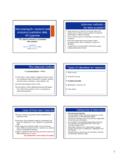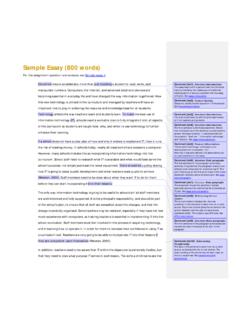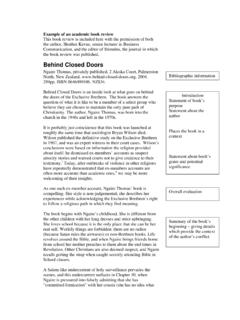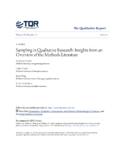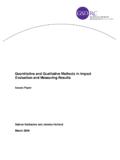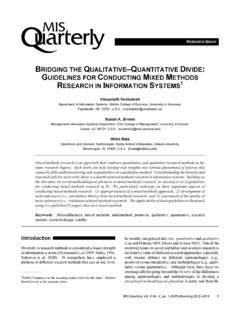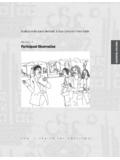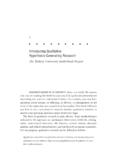Transcription of Interview methods – Interviewing for research and
1 1 Interviewing for research and analysing qualitative data: An overview (revised May, 2011) The Interview method is a conversation with a purpose Martin WoodsSchool of Health & Social ServicesMassey UniversityInterview methods for what purpose? Large amounts of relevant information about the experiences of others may be collected by directly questioning or talking to people. Some research questions are better answered in such Some research questions are better answered in such a fashion. Interviews, especially unstructured or semi-structured ones, offer considerable researcher flexibility. A great deal of research within at least the social sciences depends on them!The Interview non-experimentalin Interview is used widely to supplement and extend our knowledge about individual(s) thoughts, feelingsour knowledge about individual(s) thoughts, feelings and behaviours, meanings, interpretations, etc.
2 One of the best ways to achieve interviewer collects detailed personal information from individuals usually in one to one situations using oral questions. Types of interviews for research1) Brief survey2) Extensive survey3) In-depth interviews4) Monologue, narrative, etc5) Case of Interview materialsInterview material may provide either quantitative or qualitative argue that quantitative data is considered to be easier to analyse and more reliable than qualitativeeasier to analyse and more reliable than qualitative data. Others argue that qualitative data is less structured, more difficult to analyse but the results are as valid as those in quantitative research . However, qualitative data may help to explain some very difficult questions or presentation covers mainly this of interviews1. The structured Interview The key feature of the structured Interview is in the pre-planning of all the questions asked.
3 Structured interviews also allow for exact replication of the Interview with others. To an extent, it is possible to generalise what youTo an extent, it is possible to generalise what you find out about the population from which your Interview sample came. Structured interviews are conducted in various modes: face-to-face, by telephone, videophone and the Internet. Questionnaires and surveys are common examples of structured Interview the semi-structured Interview A key feature of the semi-structured Interview is in the partial pre-planning of the questions. Semi-structured interviews still allow for replication of the Interview with others, but are be less controlled. Semi-structured interviews may be conducted in yvarious modes: face-to-face, by telephone, but face-to face is probably best. A great deal of qualitative research (grounded theory, thematic analysis, etc) uses semi-structured Interview material).
4 The semi-structured Interview :benefits and disadvantages The primary advantage of in-depth interviews is that they provide much more detailed information than what is available through other data collection methods , such as surveys. Standardisation of at least some of the questions increases data Standardisation of at least some of the questions increases data reliability. Replication possible. Ability to ask some spontaneous questions is sensitive to participants need to express also may provide a more relaxed atmosphere in which to collect information people may feel more comfortable having a conversation with you as opposed to filling out a survey. Limitations of in-depth interviews The use of an occasional spontaneous question makes the answers difficult to quantify and analyse. Spontaneous questions asked of some and not of others can be seen as unfair, or possibly misleading. Can be time-intensive Can be time-intensive The interviewer must be capable of performing reliable interviews Not generalisable Prone to possible bias Pre- Interview preparationPlanningIdentify likely participants to be an adequate sample size if research will follow international and national ethical research standards, including review by ethical research committees.
5 Pre- Interview IIDeveloping What to say to interviewees when setting up the Interview ; What to say to interviewees when beginningthe Interview - including ensuring informed consent and confidentiality of the intervieweeand what to say toconfidentiality of the interviewee and what to say to interviewees in concludingthe Interview ; What to do during the Interview ( take notes, audiotape, etc); What to do following the Interview ( more notes and/or check audiotape for clarity; perhaps summarize key thoughts). Stages of an interviewThere are at least five stages:1. Arrival It d tiIntroductions, background noise checks, getting to know each other, Setting up audiotape/ recording equipment, settling down, the researchExplain: the purpose of the Interview , why the participant has been chosen, and the expected duration of the iSeek informed consent of the interviewee: Use the information sheet, explanation of how the information is confidential, etc.
6 , the use of note taking and/or the tape recorder, written or documented oral consent. If the interviewee has consented, conduct the the interviewGradually, unhurried, open-ended questions. Semi-structured Although you should have some pre-planned questions to ask during the Interview , you must also lltit fltllbdallow questions to flow naturally, based on information provided by the respondent. Do not insist upon asking specific questions in a specific order. In fact, the flow of the conversation dictates the questions asked, and those omitted, as well as the order of the to remember when interviewingThe interviewer: must make the interviewee comfortable. appear interested in what they are saying. avoid yes/no and leading questions. Use appropriate body language. Keep personal opinions in to avoid when Interviewing Biased questions: Questions that assume what they ask: Double-barrelled questions: Questions that do not directly relate to what you want to find out: Confusing or complicated questions:4.
7 Keeping focussed: More Interview tipsQuestions should be open-ended rather than closed-ended. You should usually ask a factual question before an opinion question. Use probing questions as These include: Would you give me an example? Can you elaborate on that idea? Would you explain that further? I m not sure I understand what you re Is there anything else?Keeping focussed IISeek understanding and to interpret what you are hearing, as well as seek clarity and a deeper understanding from the respondent throughout the conversational but remember your role is primarily that of a listener. Do not force or push the pace unnecessarily, or put words into the participant s mouth .There should be smooth transitions from one topic to the the interviewFinish on time if possible, but try to make sure everything has been covered blMake sure that you have made a suitable arrangement with the participant concerning the reviewing of the transcript the participant for their valuable basic things to remember1.
8 Background noises can really affect the quality of any Faulty recording equipment can be People often say some very interesting things after the pyyggrecording device has been turned Not every session will last the full amount of What is not said may sometimes be of considerable interest in an Participant body and facial gestures, pauses, silence, laughter, etc can be of Transcribing is a lot of hard Good transcribers are worth their weight in on the preliminary analysis of Interview data Read through the Interview responses and look for patterns or themes among the data. You should be able to discover a variety of themes, codes, or even possible categories that will provide ,pgpthe beginnings of analysis, and/or ideas for future interviews. You may, for example, find that younger participants tend to think and feel differently from older ones, or that men and women respond differently to the same questions, etc.
9 You can also get some useful ideas for how to improve the next interviews, or which areas to pursue, to do with all that data? qualitative research results in large amounts of richly detailed data that is contextually laden and subjective. This data usually originates from Interview transcripts and/or observation notes and must be re orked or red ced to representreworked or reduced to represent major themes or categories that describe the phenomenon being studied. Data reduction facilitates the revealing of findings simply and efficiently. This process depends upon the nature of the research , and especially on the chosen analytical data analysis; a fewpossible approaches1. Thematic analysis2. Grounded theory3. Discourse analysis4. data analysis-Potential issues/pitfalls1. Data shock!2. The problem of to do about available to do about a a ab e te atu e4. The wandering in the desert syndrome; issues surrounding the identification of relevant data(includes data coding concerns).
10 5. The need for adequate reflection to allow the aha! moments to filter Managing all the various mind mapping .7. Writing it all up. 5 qualitative data analysisQualitative data analysis consists of identifying, coding, and categorizing patterns or themes found in the data. The clarity and applicability of the findings heavily depend on the analytic abilities of the on the analytic abilities of the researcher. This dependence on the abilities of the analyst can be the greatest strength or the greatest weakness of a qualitative research study. It is crucial that the researcher reports and documents his or her analytic processes and procedures fully and truthfully so others may evaluate the credibility of the researcher and his or her findings. The use of literature in data management/analysisThe use of literature in qualitative analysis may vary In thematic analysis it may be extensive before data analysis commences in earnestanalysis commences in it may also be contraindicated, as in grounded Glaser (1992, p.)
